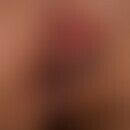Synonym(s)
DefinitionThis section has been translated automatically.
Infectious diseases caused by parasitic fungi.
ClassificationThis section has been translated automatically.
A distinction is made (see Table 1):
-
Dermatomycoses (mycoses of the skin)
- dermatophytoses
- yeast infections of the skin
- Mould infections of the skin
- Deep mycoses
- System mycoses.
You might also be interested in
DiagnosisThis section has been translated automatically.
- Pathogen detection (here especially for dermatomycoses; see also mycology examination methods):
- Potassium hydroxide native preparation: Skin scales are dissolved in 20% potassium hydroxide solution. The microscopic picture shows the fungal filaments without special staining. Indication of fungal infection, but not species or even group affiliation (dermatophytes, yeasts, moulds = DHS system).
- Other st ains: Certain stains (Congo Red, Methylene Blue, Chlorazol Black) make fungi stand out particularly well against skin scales. Native preparations of Pityriasis versicolor are particularly suitable for staining according to Parker (drop equal volumes of blue ink and KOH onto the preparation). The colour is immediately taken up by the Malassezia spp!
- Periodic acid-Schiff staining (PAS) in the histological preparation: In this highly sensitive histological procedure, fungal filaments and spores stain red. A differentiation of mould, dermatophyte mycelium and pseudomycelium of pathogenic yeasts is not possible by this optical method.
- Fluorescence microscopy: The microscopic diagnosis of cala eyes is much more successful by using much more sensitive fluorescence microscopic methods with optical brighteners from the group of diaminostilbenes(Calcofluor white, Blankophor). These dyes specifically attach to the chitin of the fungal cell wall. Human keratin is only weakly stained (caution: cellulose, e.g. cotton threads, also fluoresce).
- Wood-lamp: Greenish fluorescence, especially used for microsporiasis, favus, tinea inguinalis.
- Culture (gold standard): On special culture media (e.g. Sabouraud glucose and Kimmig agar) dermatophytes grow within 1-4 weeks, moulds within 1-2 weeks and yeasts within 3-4 days. By growth form and colour of the culture a tentative diagnosis is possible.
- Microculture: Precise microscopic differentiation by micro- and macroconidia, chlamydospores, shape and arrangement of blastospores and pseudomycelia.
- Molecular diagnostics: PCR-based genetic identification method. Advantage: Faster, more sensitive and less susceptible than culture methods (interference due to pretreatment). For the genetic identification of dermatophytes, characteristic DNA segments of genes such as mitochondrial genes, genes of chitin synthase, DNA topisomerase, superoxide dismutase, actin and tubulin are isolated, amplified by primers and detected by gel electrophoresis or ELISA.
- Detection by MALDI-TOF analysis. For dermatomycoses still to be described as experimental. Already more widely used for mould infections.
TherapyThis section has been translated automatically.
TablesThis section has been translated automatically.
The most important mycoses in humans
Disease |
Pathogen |
Remarks |
|
Primary system mycoses |
Coccidioides immitis |
pulmonary mycosis; inhalation of spores; occurrence in the southwest of the USA and in South America |
|
histoplasm capsulatum |
pulmonary mycosis; inhalation of spores; dissemination into RES; occurrence in America, Africa, Asia |
||
blastomyces dermatitidis |
primary lung mycosis; secondary spread (skin); occurrence in North America, Africa |
||
Paracoccidioides brasiliensis |
primary pulmonary mycosis; secondary spread (skin, mucosa) |
||
| |||
Opportunistic system mycoses |
Candidosis (thrush) |
Candida albicans; other Candida spp. |
endogenous infection; primarily infects mucous membranes and skin; secondary spread to other organs |
Aspergillus fumigatus (90%); other Aspergillus species |
bronchopulmonary A., aspergilloma; otitis externa; endophthalmitis; septic aspergillosis |
||
Cryprococcus neoformans |
aerogenic infection; lung cryptococcosis; secondary spread into the CNS and meningoezephalitis |
||
|
(zygomycoses) (S.a. infection by entomophthorales) |
Mucor spp.; Rhizopus spp.; Absidia spp.; Cuninghamella spp. and others |
rhinocerebral, pulmonary, gastrointestinal and/or cutaneous mucor mycosis |
|
Phaeohyphomycoses (mycoses caused by Dematiaceae, also called "black fungus"). |
Curvularia spp.; Bipolaris spp.; Alternaria spp. and others; black-brown pigments |
Infections of various organs in immunocompromised patients, also septic clinical pictures are described |
|
Hyalohyphomycoses (mycoses caused by hyaline fungi); recently unknown |
Fusarium spp.; Sopulariopsis spp.; Pseudoallescheria spp. and others |
Infections of various organs in immunocompromised patients; septic clinical pictures are also described |
|
Opportunistic yeast mycoses (except candidiasis); many pathogens were not known as pathogens until recently |
Torulopsis glabrata; Trichosporon beigelii; Rhodotorula spp.; Malassezia spp.; Hansenula anomala; Saccharomyces spp. and others |
Infections of various organs in immunocompromised patients; septic clinical pictures are also described. Malassezia furfur in catheter sepsis of newborns and intralipid therapy of adults |
|
| |||
Subcutaneous mycoses |
Sporothrix schenckii |
dimorphic fungus; ulcerous lesions on extremities |
|
Phialophora verrucosa; Fonsecaea pedrosoi; Cladosporium carrionii et al. |
black molds; wartlike, pigmented lesions on extremities; tropical disease |
||
Mycetoma (maduramycosis) |
Madurella mycetomi; Scedosporium apiospermum et al. |
subcutaneous abscesses in the foot or hand area; can also be caused by bacteria; in tropics and subtropics |
|
| |||
Cutaneous mycoses |
Malassezia species |
superficial infection; harmless; pathogen dependent on fatty acids |
|
dermatomycoses: Tinea pedis, T. cruris, T. capitis, T. barbae, T. unguinum, T. corporis |
Trichophyton spp.; Microsporum spp.; Epidermophyton spp. |
all dermatophytes are filamentous fungi; anthropophilic, zoophilic, geophilic species; always contact infections |
|
LiteratureThis section has been translated automatically.
- Brasch J (2012) News on diagnostics and therapy of mycoses. Dermatologist 63: 390-395
- Nenoff, P et al (2014) Mycology - An Update Part 2: Dermatomycoses: Clinical picture and diagnostics. JDDG 12:749-778
- Seebacher C et al (2007) Tinea of the free skin. J Dtsch Dermatol Ges 11: 921-926
Incoming links (58)
Amorolfin; Anthrarobin; Antimycotics; Bifonazole; Blastomycosis of the jorge-lobo type; Blepharitis mycotica; Cephalosporiosis; Chromomycosis; Ciclopirox; Citronella; ... Show allOutgoing links (34)
Aspergillosis; Blastomycosis, north american; Blastomycosis south american; Calcofluor-white staining; Candida; Candidoses; Chromomycosis; Coccidioidomycosis; Cryptococcosis; Dermatomycoses; ... Show allDisclaimer
Please ask your physician for a reliable diagnosis. This website is only meant as a reference.




